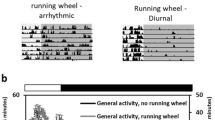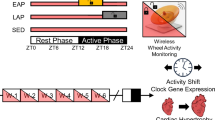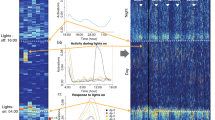Abstract
Objective:
To examine the impact of two diets differing in fat content and of wheel-running exercise on body mass.
Methods:
A total of 32 female C57BL/6J mice were assigned to either a high-fat (HF, 41% of dietary energy as fat) or low-fat (LF, 11% of dietary energy as fat) diet (16 per diet, individually housed). Eight mice from each diet group were housed with running wheels. Non-running mice were housed in similar cages, without wheels. Total cage activity (including non-exercise physical activity +wheel running) and sleep time were also measured using an infra-red-sensing device. Oestrus stage of the wheel-running mice was assessed daily for 17 days.
Results:
After 8 weeks, HF mice were significantly heavier than LF mice (P=0.004), but there was no detectable difference in body fat mass. Wheel-running mice tended to have a lower body mass than non-running controls (P=0.056). Voluntary cage activity was greater in LF control mice than HF control mice, and in wheel-running mice compared with non-wheel-running mice. HF control mice slept more than LF control mice. Stage of oestrus was significantly correlated with running distance, with mice running farthest in the immediate preoestrus phase and least immediately after oestrus.
Conclusion:
This study shows that HF diets in female C57BL/6J mice may increase sleep time similar to the effect of daytime sleepiness observed in obese humans.
This is a preview of subscription content, access via your institution
Access options
Subscribe to this journal
Receive 12 print issues and online access
$259.00 per year
only $21.58 per issue
Buy this article
- Purchase on Springer Link
- Instant access to full article PDF
Prices may be subject to local taxes which are calculated during checkout




Similar content being viewed by others
References
Fontaine KR, Redden DT, Wang CX, Westfall AO, Allison DB . Years of life lost due to obesity. JAMA 2003; 289: 187–193.
Kopelman PG . Obesity as a medical problem. Nature 2000; 404: 635–643.
Lumeng JC, Somashekar D, Appugliese D, Kaciroti N, Corwyn RF, Bradley RH . Shorter sleep duration is associated with increased risk for being overweight at ages 9 to 12 years. Pediatrics 2007; 120: 1020–1029.
van den Berg JF, Knvistingh Neven A, Tulen JHM, Hofman A, Witteman JCM, Miedema HME et al. Actigraphic sleep duration and fragmentation are related to obesity in the elderly: the Rotterdam Study. Int J Obes 2008; 32: 1083–1090.
Jennings JR, Muldoon MF, Hall M, Buysse DJ, Manuck SB . Self-reported sleep quality is associated with the metabolic syndrome. Sleep 2007; 30: 219–223.
Waters KA, Mast BT, Vella S, De la Eva R, O’Brien LM, Bailey S et al. Structural equation modeling of sleep apnea, inflammation, and metabolic dysfunction in children. J Sleep Res 2007; 16: 388–395.
Vgontzas AN, Bixler EO, Chrousos GP . Obesity-related sleepiness and fatigue—the role of the stress system and cytokines. Stress Obesity Metabol Syndr 2006; 1083: 329–344.
Jenkins JB, Omori T, Guan Z, Vgontzas AN, Bixler EO, Fang J . Sleep is increased in mice with obesity induced by high-fat food. Physiol Behavior 2006; 87: 255–262.
Richter CP . Animal behavior and internal drives. Q Rev Biol 1927; 2: 307–343.
Konhilas JP, Maass AH, Luckey SW, Stauffer BL, Olson EN, Leinwand LA . Sex modifies exercise and cardiac adaptation in mice. Am J Physiol Heart Circ Physiol 2004; 287: H2768–H2776.
De Bono JP, Adlam D, Paterson DJ, Channon KM . Novel quantitative phenotypes of exercise training in mouse models. Am J Physiol Regul Integr Comp Physiol 2006; 290: R926–R934.
Lightfoot JT, Turner MJ, Daves M, Vordermark A, Kleeberger SR . Genetic influence on daily wheel running activity level. Physiol Genomics 2004; 19: 270–276.
Bell RR, Spencer MJ, Sherriff JL . Voluntary exercise and monounsaturated canola oil reduce fat gain in mice fed diets high in fat. J Nutr 1997; 127: 2006–2010.
Austin CR, Rollands IW In: Short DJ, Woodnott DP (eds). IAT Manual of Laboratory Animal Practice and Techniques, 2nd edn. Crosby Lockwood and Sons Ltd: London, 1969, pp 340–349.
McAlister FA, Straus SE, Sackett DL, Altman DG . Analysis and reporting of factorial trials: a systematic review. JAMA 2003; 289: 2545–2553.
Kohsaka A, Laposky AD, Ramsey KM, Estrada C, Joshu C, Kobayashi Y et al. High-fat diet disrupts behavioral and molecular circadian rhythms in mice. Cell Metab 2007; 6: 414–421.
Turek FW, Joshu C, Kohsaka A, Lin E, Ivanova G, McDearmon E et al. Obesity and metabolic syndrome in circadian Clock mutant mice. Science 2005; 308: 1043–1045.
Turner MJ, Kleeberger SR, Lightfoot JT . Influence of genetic background on daily running-wheel activity differs with aging. Physiol Genomics 2005; 22: 76–85.
Rogers CJ, Berrigan D, Zaharoff DA, Hance KW, Patel AC, Perkins SN et al. Energy restriction and exercise differentially enhance components of systemic and mucosal immunity in mice. J Nutr 2008; 138: 115–122.
Bronikowski AM, Carter PA, Swallow JG, Girard IA, Rhodes JS, Garland T . Open-field behavior of house mice selectively bred for high voluntary wheel-running. Behav Genet 2001; 31: 309–316.
Tang X, Xiao J, Parris BS, Fang J, Sanford LD . Differential effects of two types of environmental novelty on activity and sleep in BALB/cJ and C57BL/6J mice. Physiol Behav 2005; 85: 419–429.
Pack AI, Galante RJ, Maislin G, Cater J, Metaxas D, Lu S et al. Novel method for high-throughput phenotyping of sleep in mice. Physiol Genomics 2007; 28: 232–238.
Funkat A, Massa CM, Jovanovska V, Proietto J, Andrikopoulos S . Metabolic adaptations of three inbred strains of mice (C57BL6, DBA/2, and 129T2) in response to a high-fat diet. J Nutr 2004; 134: 3264–3269.
Almind K, Kahn CR . Genetic determinants of energy expenditure and insulin resistance in diet-induced obesity in mice. Diabetes 2004; 53: 3274–3285.
Bartol-Munier I, Gourmelen S, Pevet P, Challet E . Combined effects of high-fat feeding and circadian desynchronization. Int J Obes 2006; 30: 60–67.
Richards MPM . Activity measured by running wheels and observation during the oestrus cycle, pregnancy and pseudopregnancy in the golden hamster. Anim Behav 1966; 14: 450–458.
Anantharamanbarr HG, Decombaz J . The effect of wheel running and the estrous-cycle on energy-expenditure in female rats. Physio Behav 1989; 46: 259–263.
Gorzek JF, Hendrickson KC, Forstner JP, Rixen JL, Moran AL, Lowe DA . Estradiol and tamoxifen reverse ovariectomy-induced physical inactivity in mice. Medicine Science Sports Exercise 2007; 39: 248–256.
Norman JF, Von Essen SG, Fuchs RH, McElligott M . Exercise training effect on obstructive sleep apnea syndrome. Sleep Res Online 2000; 3: 121–129.
Acknowledgements
We thank the World Cancer Research Fund for financial support (Project number 2001/38), Adele Kitching and Sandra Hogg for care of the animals and Fiona MacLachlan for help with the body composition analysis. L Basterfield designed the study, collected and analysed data and wrote the paper. L Lumley collected and analysed data and JC Mathers designed the study, supervised the project and wrote the paper.
Author information
Authors and Affiliations
Corresponding authors
Rights and permissions
About this article
Cite this article
Basterfield, L., Lumley, L. & Mathers, J. Wheel running in female C57BL/6J mice: impact of oestrus and dietary fat and effects on sleep and body mass. Int J Obes 33, 212–218 (2009). https://doi.org/10.1038/ijo.2008.253
Received:
Revised:
Accepted:
Published:
Issue Date:
DOI: https://doi.org/10.1038/ijo.2008.253
Keywords
This article is cited by
-
The fast and the curious III: speed, endurance, activity, and exploration in mice
Behavioral Ecology and Sociobiology (2023)
-
Sex differences in variability across timescales in BALB/c mice
Biology of Sex Differences (2017)
-
An association between liraglutide treatment and reduction in excessive daytime sleepiness in obese subjects with type 2 diabetes
BMC Endocrine Disorders (2015)
-
Estrogens, inflammation and obesity: an overview
Frontiers in Biology (2012)



